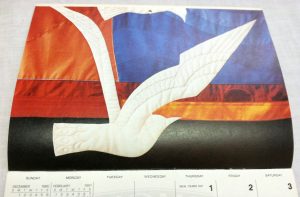
Susan Hertel and Alba Cisneros, wall hanging for Torrance branch, Home Savings, 1980. Image courtesy of Alba Cisneros.
The vast majority of Home Savings’s distinctive art and architecture cannot be moved easily: mosaics; stained glass; giant painted murals; large sculptures; and the architecture of the buildings themselves. In a few cases, they have been torn down or painted over, but for the most part the artwork is in place, though at times hidden or damaged by changes to the bank’s layout, security, or convenience features.
But this week I want to focus on that which was movable from the Home Savings banks, and see if you my avid Internet audience might have ideas on where items are. There are some wood-panel murals that have been removed from the Pasadena Home Savings and the Pomona Buffum’s, as well as the mural from the Beverly Wilshire Hotel; these all seem to be safely maintained. There are the original Millard Sheets sketches for Home Savings projects, some of which are for sale by Alan Wofsy Fine Arts. And there are various commemorative brochures and prints offered at the openings of Home Savings in Beverly Hills and Hollywood, and Pomona First Federal in Claremont and Pomona; I have seen a number of each, some in library collections. There are calendars and advertisements too, with fascinating messages, which are harder to find — more on that in another post.

Susan Hertel and Alba Cisneros, wall hanging for Huntington Harbor branch, 1979, in 1980 Home Savings calendar. Image courtesy of John Wallis and Associates stained glass.
But what about these wall hangings, done for Huntington Harbor and Torrance, or the mosaic tables produced by the Millard Sheets Studio for Lakewood, the Van Ness branch in San Francisco, and the Arden Way branch in Sacramento? Can anyone say if any of those survive? (I also hear there is a version of the Home Savings shield done in stained glass for an Ahmanson Center corporate office; I am keeping track of these movables as I mull whether an exhibit might be possible alongside my book.)
The wall hangings are especially interesting, as they are more quilting or embroidery, rather than the tapestries that the Studio produced earlier for the Foley Communication Arts Center at LMU, as well as the Garrison Theater, produced in Aubusson, France. (It is unclear what kind of fabric art was in the Home Savings branches at Montebello and Mountain View as well.)
Alba Cisneros, who worked in the studio for many years, recalls having these wall hangings stretched out across her living room, sewing them quickly for the bank opening. Their theme and color palette, by Sue Hertel, reflect traditional Home Savings designs, but the new medium provides new textures and depth of color — as well as the portability that leads to the question of where they are.
Do you have leads on any of these items? Are any still in these banks? Have they been preserved? Do let me know.
Also: a REMINDER of the L.A. Conservancy’s Millard Sheets tour in Claremont and Pomona on Sunday, March 18, 10:00am-4:00pm. At 5:00pm there will be a panel discussion with Carolyn Sheets Owen-Towle (Millard’s daughter), sculptors Betty Davenport Ford and John Edward Svenson, architect Rufus Turner, and Studio mosaicist Brian Worley — and I will introduce the session with slides relating the tour sites to my overall research. I assume lots of others involved with this artwork will be there too. Hope to see you!
Hi Adam,
most of the wall hangings were designed and created by other artists who worked with Dad. Susan Hertel, Martha Menke Underwood, who died recently and others. That does not justify their being gone, however they were not an integral part of the building like mosaics and murals, more like paintings on the wall. several of mine have disappeared. See you tomorrow at AMOCA or on next Sunday’s LAC tour. Best, Tony
Hi Tony,
The wall hangings and other portable items were integral to the design of the branches where they appeared, often replacing (or complementing) mosaics and painted murals. Some, as you note, are designed by other artists, but my interest is in the art and architecture of these bank spaces from the 1950s until today, building on the ideas your father created but often going beyond them as well.
See you on the 18th!
Best,
Adam